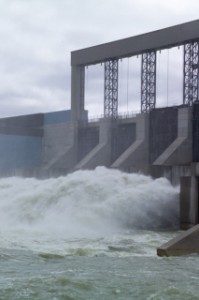 On this page, we address the following topics related to hydroelectric power in Manitoba:
On this page, we address the following topics related to hydroelectric power in Manitoba:
Click a link in the list above to jump to that topic on this page.
Advantages
Hydroelectric power in Manitoba comes from water falling through turbines within a dam. This process does not generate any greenhouse gases (GHG) during operation.
Difficulties
GHGs are produced if trees and plants are flooded by the reservoir above the hydroelectric dam. As these flooded plants decompose, they generate carbon dioxide and possibly methane. Once this decomposition is complete, no more GHGs are produced.
All new development projects require additional high-voltage direct current (HVDC) transmission lines from generation stations in the north to demand areas in the south.
On September 25, 2007, Hydro announced that they would build a new HVDC line on the west side of the province. This route is an alternative to the shorter route on the east side of Lake Winnipeg. Although the east side route would be more direct (and cheaper) it would have cut through an ecologically and culturally sensitive area. The new “BiPole III” line was completed in July 2018.
Current situation
Hydro is synonymous with electricity in a Manitoban’s vocabulary. 96% of our electricity comes from 14 hydroelectric generating stations on the Nelson, Winnipeg, Saskatchewan, and Laurie rivers (1).
Currently, Manitoba Hydro has over 5,000 megawatts (MW) of hydroelectric generating capacity (2).
Our newest dam, Wuskwatim came online in 2012. It added 200 MW of new generating capacity. When its dam was closed and the reservoir filled, it caused 0.37 sq. km of flooding. This is smaller than the gross building area of “Mall of America” in Minneapolis.
Manitobans have been setting new records for peak electricity demand:
- 4,632 megawatts (MW) on December 31, 2013 (3)
- 4,250 MW on January 30, 2008 (4)
- 4,170 MW in the winter of 2006-7 (5)
Manitoba Hydro exports its surplus power to neighbouring provinces and the mid-western United States, where much electricity is generated by burning fossil fuels.
Manitoba Hydro’s exports thus reduce the amount of fossil fuel-generated electricity needed by these out-of-province clients and consequently reduce the amount of greenhouse gases produced.
So, even though Manitobans’ electricity comes from hydro, reducing our demand reduces fossil fuel burning by making more power available for Hydro to export to areas that would others contribute high amounts of energy-related GHGs.
Future possibilities
A further 3,000 MW of hydroelectric power could still be developed in Manitoba. These are all on the lower Nelson River. This includes:
- Conawapa – 1,380 MW – Conawapa will require no significant water storage upstream and will only cause about 5 sq. km of flooding, almost entirely within the natural banks of the Nelson River (6).
- Gillam Island – 1,000 MW
- Keeyask – 630 MW – A license to develop Keeyask was granted in 2014.
The output of these developments would be used primarily for electric power exports, since the growth of Manitoba’s domestic demand will not require this capacity for at least a generation.




